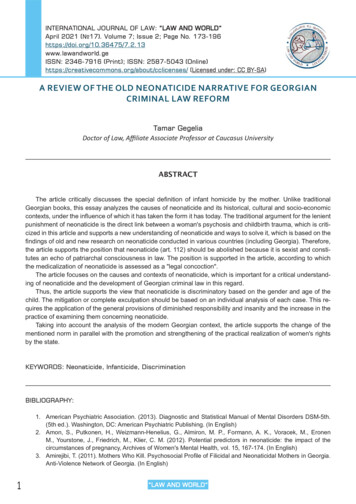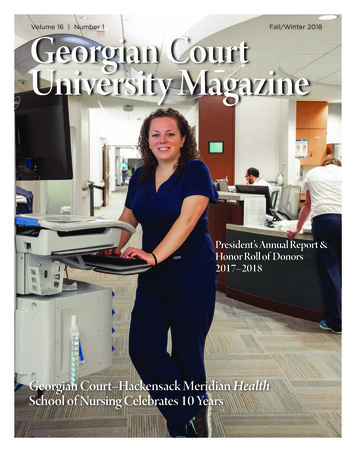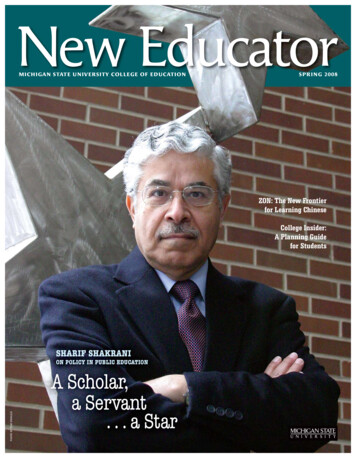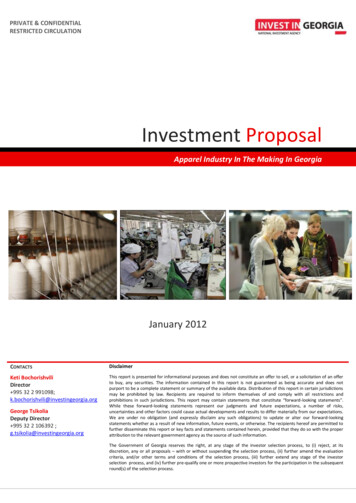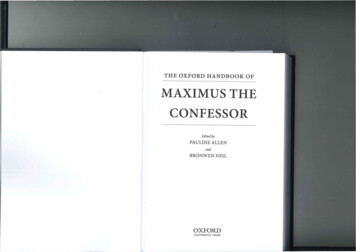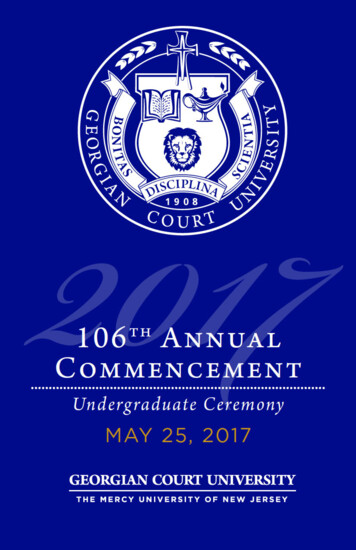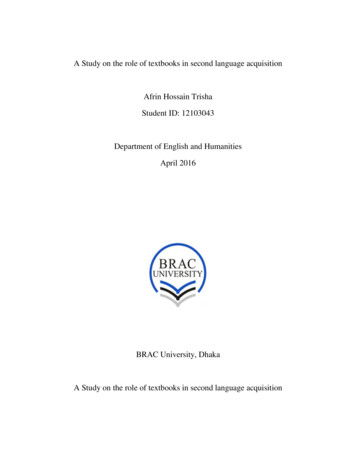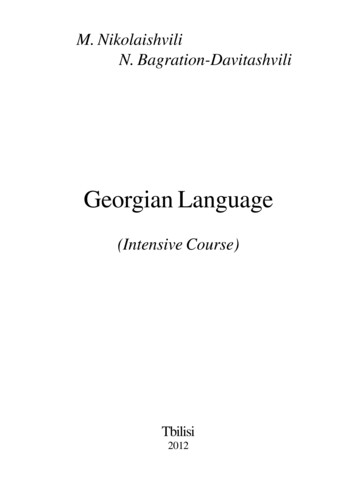
Transcription
M. NikolaishviliN. Bagration-DavitashviliGeorgian Language(Intensive Course)Tbilisi20121
УДК 809.463.1N67The present work represents the English version of M.Nikolaishvili’s book« Грузинский Язык» («Georgian Language») published in 1999. which isrecognised by the Ministry of Education of Georgia as a sound basic course textbook of the Georgian Language for the non-Georgian students.The course includes all topics needed for everyday relationsand also gives an idea of the basic grammatical peculiarities ofthe Georgian language. The book can be used as a self studycourse as well.EditorDoctor of Philological Sciences, Professor E. Babunashvili,K. GelashviliReviewers:Doctor of Philological Sciences, Professor F. Uturgaidze,Professor T. InjiaProof Reader:Lydia West.Technical Editor: P. KorkiaAll rights reserved. M. Nikolaishvili, N. Bagration-DavitashviliISBN 978-9941-0-4539-4
BY THE AUTHORThe present book represents a basic course of the Georgian language, with apreface stating the general characteristics of the grammar of this language.The book begins with the study of writing and reading. Then follow texts, thatencompass all the main topics of the language spoken in everyday life and areintended for an exact knowledge of the spoken Georgian language.There are ten topics in the book and each of them is divided into sections shorttexts, composed of the most frequently used words, grammatical explanations, theneed of which may arise from the text. The explanations concern other forms ofindividual words marked with an asterisk. Ibidem are exercises, lexical groupsconnected with a topic, and at the end, a text that includes represented dialogueson certain subjects. At the end of the book there are lexical-grammatical exercises foreach parts. All this as a whole comprises more than 2000 words.A literal translation (l.t. abbreviation) is given in some cases in order to comprehendbetter certain Georgian phrases.You should familiarize yourself with the form of the word, understand the grammar,repeat the text many times (at least 12) until you are able to repeat it at the sametempo (speed) as the speaker.Studies on one topic should last for two to three weeks.CD should be heard every day. The lessons are recorded with musical effectsto give rise to cause certain emotional reaction.3
GENERAL CHARACTERISTICS OF THE GEORGIAN LANGUAGEThere are 33 sounds in the modern Georgian language: five vowels that inpronunciation are exactly the same as there English equivalents and 28consonants, with the some that are characteristic of only the Georgian language.According to the method of formation they are divided into three groups:sonorous solitaries;fricatives pairs;occlusives triples.There are also specific consonant complexes, so called harmonious complexesthat are pronounced smoothly in the Georgian language. In the initial lessons,consonants and harmonious complexes are emphasized to attract your attentionand to enable you to master them easily.Georgian is a so called agglutinative language: grammatical (morphological)categories are expressed by means of appropriate affixes (prefixes and suffixes)and each affix has its function. Of course there are exceptions, such as, whentwo grammatical categories are expressed by one affix.There is no category of gender. There are seven cases: Nominative, Ergative,Dative, Genitive, Ablative, Adverbial and Vocative. Case inflections are thesame in both the singular and plural forms, but in the plural suffixes formingthe plural are added to the stem, because a number of phonetical changes(reduction and clipping) depend on them. Special attention should be paid tothe so called Ergative case, which has no equivalent in English or in anyIndoEuropean language. This case is used only for the expression of the subjectin the construction of active verbs in the past perfect tense and in its subjunctive.In English there is no Adverbial case either, that is used for the expression ofsecondary parts of a sentence.As in all languages, pronouns have an original declension. Their forms shouldbe memorized.The most difficult part of speech in Georgian is the verb in that it may bemono-personal, bi-personal and tri-personal. Bipersonal and tripersonal verbsare those with which two or three persons are connected by sense, but in contrastto English, these persons may be marked in the verb by means of subjective andobjective person markers. Very often personal markers in verbs are lost becauseof certain reasons. We have tried to outline and explain such cases. Thus, theverb in the Georgian language is conjugated according to both the subjectiveand objective person markers. When a verb changes according to a subjectiveperson marker, it belongs to the subjective version. When a verb changes4
according to an objective person markers, it belongs to the objective version.The difficulty of the Georgian verb arises out of the fact, that manymorphological categories are simultaneously expressed in it by means of affixes.Because of the difficulty of formation and also because of the function oftenses and moods of the Georgian verb, there are only 6 tenses and moods:present, past imperfect or past continuous, future, past perfect or past noncontinuous, II subjunctive and the I resulting are all represented in this book.Georgian syntax is also distinguished by a number of peculiarities, namely:the cases of a subject are the Nominative, the Ergative and the Dative. Directand indirect objects are similarly the main parts of a sentence as subject andpredicate. The direct object may occure in two cases the Nominative and theDative.It should be mentioned, that some peculiarities of the Georgian language thatrepresent certain difficulties are interpreted by us with a slight difference thanis usual in traditional grammars. This is done in order to present as simply aspossible quite difficult Georgian grammar and ease the learning of the spokenlanguage for the non-Georgian representatives of different professions. If weachieve this goal, we shall regard that we have achieved our objective withsuccess. But if some have a wish to learn the grammatical structure of theGeorgian language more deeply for such cases, there are many investigationsand manuals, the authors of which are well-known Georgian linguists. Weshall mention here only one of these books «Basics of Georgian languageGrammar», the author of which is the outstanding Georgian linguist,academician Akaki Shanidze.When somebody begins the study of a foreign language, he becomes certainlyinterested in the people, speaking this language and also in its culture. We havetried to satisfy this interest although not in depth.5
6
ABOUT GEORGIAGeorgia is a country with an ancient history. It lies in the Caucasus. In the eastit borders upon Azerbaijan, in the west upon the Black Sea, in the northCaucasian ridge and in the south Armenia and Turkey.Archeological finds and written sources found in almost all corners of theland clearly testify to the ancient origin of the Georgian people. The earliestfind is a mandible of a primitive man (2,5 mln 700 thousand years) foundunder the medieval site of the ancient settlement of Dmanisi.The burial grounds and remains of settlements of the VI millennium B.C. andalmost all the following ages are to be found on the territory of Georgia.From an archeological point of view Georgia is especially rich in materials ofthe Hellenistic – late ancient period (IVcentury B.C. IV century A.D.) .It was atime when the Georgian states were forming. Two Georgian states Kolkheti(West Georgia) and Iberia or Kartli (East and South Georgia) had already existedfor 2600 years. The founder of the latter was a native of Mtskheta, KingParnavaz liberator. In the VII century B.C. Mtskheta became the capital of thestate of Kartli.The Georgian alphabet also has an ancient history. It belongs to one of the 14ancient alphabets of the world and is distinguished by its originality. Thechronicler and historian of the XI century, Leonti Mroveli, connects the creationof the Georgian alphabet with the name of King Parnavaz.An ancient Georgian inscription was found in Palestine. The well-known Italianarcheologist, Virgilio Korbo, found in 1952-53 in Palestine, in the Judaicdesert near Bethlehem the ruins of a Georgian monastery with three preservedGeorgian inscriptions. The most ancient of them dates from 432-452.On the territory of Georgia an ancient Georgian inscription (493-494) can beseen in the church of Bolnisi Sion.The first literary writing «The Martyrdom of the St Queen Shushanik», wasby Jakob Tsurtaveli and was written in 476483.According to legend the first time Christianity was preached in West Georgiain the first century A.D., during the reign of Aderk by Saint Andrew and Simonthe Canaanite, but the king did not adopt the new religion and Christianity didnot spread. In the IV century, in 337, King Mirian declared Christianity to bethe state religion. The enlightener was a young lady from Capadoccia, St. Nino,who brought with her a cross made from vine branches bound with her ownhair.7
After that king Mirian built in Mtskheta the first wooden church«SvetiTskhoveli».In the second half of the V century King Vakhtang Gorgasali announced thatTbilisi would be the new capital of Georgia. According to a popular legend,while hunting in the environs of present day Tbilisi the king shot a pheasant,which fell into a hot spring and was boiled. There was an unusual odour. Theking ordered a city to be built on the site and himself gave it the name «Tpili»(warm).In the course of history the name underwent changes and now the capital ofGeorgia is called «Tbilisi». From ancient times, travellers were delighted withthe sulphur baths of Tbilisi. According to a Persian document there were «65bath-houses» in Tbilisi in the XIII century. The sulphur waters of Tbilisi haveimportant therapeutic properties.Because of its geopolitical position and beautiful scenery Georgia has alwaysappeared to be a tasty morsel for foreign invaders. That is why the history ofGeorgia is written in blood. The Georgian always had in his hand a sword readyfor the defence of his native land.In the beginning of the XII century appeared the greatest statesman, politicianand cultural figure – David Bagrationi (1089-1125) whom people named Davidthe Builder. The king was a far-sighted and wise ruler. He managed to restorethe power of the country to foreign invaders and united his country. He liberatedTbilisi from the Arab yoke that had lasted for seven centuries and declared it asthe permanent capital of Georgia. King David joined to his possessions land onboth sides of the Caucasus from sea to sea, «from Nikopsia to Darubandi» andcreated a united Caucasian state. This educated sovereign laid the foundationfor « the golden era» of the Georgian state, that achieved its highest point at theend of the XII and beginning of the XIII centuries during the reign of QueenTamar (11841213).Majestic churches and monasteries: Ikorta, Kvatakhevi, Ikalto, Gelati, Geguti,Bertubani, Kintsvisi, Betania, Ubisi and others were built in the XII century.Shota Rustaveli the author of the immortal poem «Knight in the Tiger’s Skin»,and also the outstanding philosophers: Ephrem Mtsire, Ioane Petrici, ArsenIkaltoeli, Goldengravers Beka and Beshken Opisari all created theirmasterpieces in the same period.In the 1230s Georgia fell under the yoke of new conquerers – the Mongols.After a hundred years fight the Georgians managed to restore a unitedindependent country.8
But new wars and disasters followed at the end of the XVIII century a treatywas concluded between Russia and Georgia (KartlKakheti), according to whichGeorgia became an ally of Russia. But in 1801 the Russian Emperor AlexandrI issued a manifest due to which KartlKakheti state was abolished and joinedto Russia. Georgia no longer existed as an independent country. In 1918 theGeorgian democratic republic was created. In 1921 its independence was againlost but was restored in 1991. Today Georgia is an independent country, with aPresident and Parliament at the head.Shota Rustaveli«Knight in the tiger’s skin»The first printed book. 1712Portrait of Shota RustaveliFresco from a Jerusalem monastery, XIIc.Folk Song «Urmuli» («Bullockchart»)Performed by A. Gonashvili and «Rustavi»ensemble, Art supervisor A.Erkomaishvili9
1234756101.Mount Kazbegi (5055m)2.Pitsunda, a resort on the Black Seacoast2. Jvari, church near the city of8Mtskheta, VIc, situated on a mountainnear the merging of the Mtkvari andAragvi Rivers.4. Plate of St. George – fighting a dragon, XV Georgian cloisonne enamelwork.5,6,7 Georgian fruit8. Svetitskhoveli Cathedral in the city of Mtskheta, built 1010-1023 bythe Georgian architect Arsakisdze
Part IReading and Writing
12
In the modern Georgian language there are 33 sounds that have their writtensigns, i.e. letters. Each letter of the Georgian alphabet represents a sound, whichis pronounced almost always the same. Cursive letters insignificantly differ fromprinted ones. There are also no capital letters. Only one symbol is used todesignate one sound. In consequence of these peculiarities Georgian orthographyis simple as compared with English that of many and other languages. If youpronounce the word correctly, you will always write it correctly. That is why wegive special attention to the pronunciation of sounds that are not in English, butcharacterize Georgian.There are 5 vowels in Georgian and all of them are pronounced as in English.As for consonants the matter is more difficult.Some of them are like English ones, others differ.Consonants, which are pronounced as in English:# b ( g % d 7 v, ; z, - l . m / n 3 r 4 s, š(sh), č(ch), ? (j), ) h, t, ' p, 2 kThe different consonants:1 5 ,p.t.voiceless glottalized consonants which we mark with stops.k. 8 they are compound consonants. we have correspondencepronounce in English. As for others: c, 8 c. , č. .9the place of articulation is a long the back of the tongue and the softpate. xvoiced, 9 voiceless: [.q] voiceless glottalized. The root of the tongue is pressed against the backwall of the pharynx. [z] voiced pronounced as in the English word [measure], ) guttural aspiratedfricative h.The cassettes will help you to pronounce each of them clearly.13
WRITING OF GEORGIAN LETTERSGeorgian letters are written in a fourlined net as in English, but the letters have noslope. Some of the Georgian letters exceed the line upwards or downwards. Twoletters exceed both up and down. The letters are shown not in alphabetical order,but according to the similarity of their outlines.On the line are written:One is located on the line, two exceed it upwards:Are on the line and exceed it upwards: (dz) 14š(sh) bszrxč (ch)
Begin on the line and go downwards: žBegin below the line and exceed upwards onto the line: γ ( )Begin on the line and go down: Exceed the line upwards and downwards:k 15
Georgian writing has passed through three stages of development: asomtavruli (capitals), nuskhuri, and mkhedruli.Texts written in asomtavruli are found until theXI century, nuskhuri began to spread from the XI to XIX centuries,and mkhedruli, which we use at present, appeared in the X century. Each type of Georgian writing: asomtavruli,nuskhuri and mkhedruli show a regular development as regards graphic outline.16
READ ALOUD BY SYLLABLE BY SYLLABLE!Proper names composed from sounds that are also in English are given below.*" ."*" ."3* &." .&3* .04& .;*" ."/"/" "/" /"/" /*/0 /0/" /6/6 /"/6-* 4"#" -*" -"-* -*-* -&-" -&*-" -"."3" -" " .".*" ."3*/& &-&/& ("(" ;";" ;*/" ;"*3" *".;& 3"."; 30."/ .63."/ 4040 4&4& 4"-0.& 40-0.0/ 7"/0 7" " *0 ."%0/" 6 6/" #& "/ 3&7"; 03&/" "-7" 903& "/ .*9&*- 97* " #"#"-& #&-" #&/0 ;""- *"4& *7"/& .&3"# %0%0 %"-* %*"/" %&./" .*90 #"%3* #"97" -&7"/ " " * 0 3646%"/ *4"/" "/* ."3*". "/;03 6 " "3 *- (*(" (0(* (*03(* (63". "34&/ "4-"/ (*7* 0/*4& 7"3-". -6*;" 3&;0 ("#3*&- .*/%*" &-*;#"3Among the earliest monuments of Christian Georgia,Bolnisi Sioni (478493) occupies one of the firstplaces as regards both historical and artistic value.Inner appearance of the church.1. Proper names are given in the Vocative case, which is used for addressing someone.Proper nouns have no case inflection in the Vocative case but are represented by a nounstem.17
Exercises for the correct pronunciation of sounds that characterize Georgian.Listen attentively. Try to imitate them well. Then repeat with the speaker::( ! ! ! ! - - ! ' ! ! ' C9( ( ( (' ' ! ! - (!(' ' ' ! G*, , ,!, ! ! ,!,' ! ' !, - - -&! D# # ) ) #!#! !) ) )')' )-)- # #- 6J / / ! ! /!/! /' /-/- /'/' / , ! ! ! ! ' ' ' ' ! ' ' ! L1 1 1! 1' !1' 1 1 ' 1 1! 18
EXAMPLES OF SOUNDSTHAT CHARACTERIZE THE GEORGIAN LANGUAGE:&"7-& &&&*" ***& *"*0 !0*& !**" *"3*&- "5* *-*1& *-*.0/ 3*%0/ */" " " &" 0." &%0 "."3 * *" 0 " '& 0 '4&/*" "#" *.* &."- 6.#&3 *. &3 0-" * *!0 "#6" 9" 6/" /" &-" "#6!" /"3"."/ /" -"/ . /7"-" 6 6/" 6'*" "4." (7"/ " (6-'"/ %&4&*/& & *,0 & 304*/& ("-"'**0/ &!-& */" */ -& !&4"/& ."3 " .;" 0 .;&'"-" . 7"3*4" 40 *!0 40 0 "*."/ " " *'3*" '3*4**/& '& &7"/ '& * " "/"4& "&0-0/ "3 &7"/ #"(3"* #"'"3 #".7" #&4*! #&'" #* */" (0 " %"7* %" 0 &-(6 " &3&!-& & 3&. 7& .*" 7*'*03 ;"'"3*" ;"'30 "."; &%03& 03/* & ."'4*.& ."!" '"*90430 '3*4 & 03& 0*/& 639" *"#&3 /7"3/7"3& 3" *&- *3"!-* /*!0-0;The walls of Bolnisi Sioni retain ancient samples of the Georgianwritten language of (493-494)19
READ ALOUDCOUNTRIES OF THE WORLD – @FB9? BF DI8LA85 !* !* & ! & ! * !& ! . '* !.!&*' !- !'& ' ! & !' -% ! % ' !! ' * . ' % *'!' %'& !' % *!! / 2 0 ! /!* !2 ! & *- & & % & * . ! & & ! &' '& ! & & ! ! &'&! !& ! ! !&!& ! * & ! !'&! ! . ! . ! *! !* ! * &*!& . **! . ** ! &! 2 % ! !*! - & *% &! ! ! & ! &'*. ! !& '& 2! '*- ! -!* !& !- ' .! 2 * ! &! *- ! & ! '%0 ! - * ! * & ! !& ' ! *-&! ! *'& ! -*'% & ! !& ! *-%!& ! * !! ! -2 ! ! . & ! CITIES OF THE WORLD – @FB9? BF D4?4D85 Write in Georgian and don’t forget the inflection of the Nominative case.London, Oslo, Berlin, Belgrad, Milan, Sophia, Barcelona, Saragosa, Derbi,Liverpool, Sidney, Delhi, BombayD4?4D85 74 BAG A8AG85 Read aloud:& *!2! '' %' !'.! . & *'! ' %! . !& *'&! ! ! ! - ' ! !*' &* * ! ! !'* ! ' ! % & * *! ' #'&*!& &* ! .*'& 2! % *! *!! . ** ! &* *'*! 1. In Georgian nouns are said to be in the Nominative case i.e. the Nominative case is the lexical form of thenoun, the inflection of the Nominative case is the lexical form of the noun. The Inflection of the Nominative case*» is added to consonant-stem nouns. Vowel-stem nouns lose the mentioned inflection in the Nominative case.That is why in the examples in Georgian * is added to nouns, that in English end with a consonant, and others,that end with a vowel in Georgian, are the same. For example: Iran America – «20
READ ALOUD AND REMEMBER!CITIES AND RESORTS OF GEORGIAF4D4E*I8?BF D4?4D85 74 HEBEG85 ! ! ! '- ! ! -%! '0-%! % . .!&. ! ' ! .! /. * ! '2-* ! 2- ! ! 0 ' '! */. * ! ! -* '* '%! -/ *- ' '' - ! ' * ! ' &! -!& & ! - # - . *! -&'*! -/& ! - .!! ! & -*! ! & ! - & !0 % *' -*! - ! / 2 ! ! & ! - *! ! ! .!& - - Write in GeorgianGori, Zugdidi, Shovi, Surami, Gudauri, Oni, Gagra, Ochamchire, Gali, Dmanisi,Bolnisi, Marneuli, GardabaniREGIONS OF GEORGIA - F4D4E*I8?BF H*K885 0 2 ! % * ' !% * ! -*! * * .-%! . & ! ' * ! ! 0 ! - ! .! 0 .! % !- ! 0 . -* ! % 0 ! % 0 . 0 ! RIVERS OF GEORGIA - F4D4E*I8?BF @7 A4E885 %*!. *! * ! *!'&! & -*! '*'0! * .! 2! ! ! 0.! !'*! /.!*! !*- - ! 0* %! !' '*! *'& ' &! * 0-* '* '%- . &! -/ ! *! -/ ! )4I M(I4 - THE BLACK SEA21
In Georgian words with a different meaning are formed from one stem bymeans of prefixes and suffixes. In these examples you can ? D4E*H? F4D4E*I8?BNationalityLanguageCountryFB@8K FB@KHE FB@K8* *HED *HEDH? *HED8* EHF EHFH? EHF8* NationalityLanguageCountry8FC4A8? 8FC4AHE 8FC4A8* FC4EF8? FC4EFH? FC4EF8* A7B8? A7HE A7B8* A8? AHE A 8* NationalityLanguageCountry A:? F8? A:? FHE A:? F G4? 8? G4? HE G4? 4 4CBA8? 4CBAHE 4CBA 4:8E@4A8? :8E@4AH? :8E@4A 458E.8A 58E.AH? F458E.A8* 9E4A: 9E4A:H? F49E4A:8* D4E*H? :I4E85 – Georgian Surnames#"(3"5*0/* "7"-*"/* ".*3& *#* "/%30/*," 7*-* #*#*-63* (&%&7"/* 7*-* (&-07"/* (63(&/* & %"%*"/* %"7* " 7*-* %*"4".* & &3*4 "7* 6."/* 7*-* *" 7*-* ." "#&-* .&-*2* 7*-* /"," * & /* "3" & '"-"7"/%* 7*-* "-*," 7*-* &37" * & * 6" * "7" & 0-0:" 7*-* 9&* & * * 7*-* 86-6,* & :0/*" 9&39&6-* & "/%*&3* "'"3* & 03 " &:4@B 8A ? D4E*I8? CB8G85 74 @J8E?85 Outstanding Georgian Writers and Poets*",0# 635"7&-* (*03(* .&3 6-& 0 " 364 "7&-* 46-9"/4"#"03#&-*"/* %"7* (63".* 7*-* "-&24"/%3& "7 "7" & (3*(003#&-*"/* /*,0-0; #"3" " 7*-* *-*" "7 "7" & ",",* 8&3& &-* *",0# (0(&#" 7*-* 7" " ' "7&-" "-&24"/%3& :";#&(* %"7*,-%*" 7*-* /*,0 -03 2*'"/* & ,0/45"/5*/& (".4"963%*" (3*(030#"2* & ("-"25*0/ 5"#* & .*9&*- "7"9* 7*-* 5* *"/ 5"#* & (0(-" -&0/* & 1"0-0 *" 7*-* 4*.0/ *207"/* *3",-* "#" * & .22
Part IIAcquaintances
T–1 :4@4E B54 Good afternoon/morning. (Hello) :4: @4E BF Good afternoon/morning. (Hello) EB:BE4 K4E How are you? :@47?B5* 4E:47 Well, thank you. )8A* EB:BE4 K4E How are you? @86 4E4 @ )4IFSo so (I feel so so l.t.) F* EB:BE 4E F** How is he (she)? 6H747 4E FHe feels bad. *DI8A EB:BEK4E* ** How are you? I8A * .4? 4A 4E :47 I4E* **(We feel very well l.t.) Very well. *DI8A EB:BE4K4E* How are you? @8 * 4I47 I4E**I’m sick. F A * EB:BE 4E 4A** How are they? F A 4E:47 4E 4AThey feel well**@8 )8A F I8A *DI8A F A – Personal PronounsPersonal PronounsSingular. .9 3IIIIII@8I)8A you Fhe, she, itPlural .3 3I8A we*DI8A you F A theyDeclension of Personal PronounsNom. ) . # ) , ', ) Erg.#% . # # , ', # Dat. # # # ) , ', # Gen. # # ) , ', # From the forms of the Genitive Case of personalpronouns are formed possessive pronounsDeclension of Possessive PronounsSg. %0 * Nom. 8@ )8A @ F Pl. %* * Nom. I8A *DI8A @4* **The verb "3*4 (is) is given in all its forms.The verb "3*4 is mono-personal and conjugatesaccording to the personal character of the subject1. @86 (I too). @8 - I 6 (too) particle. 2. Polite phrase, pronoun of II person, plural. 3. Nominative –F4K8?B5 * Ergative – @B*KEB5 * Dative – @ 68@ * Genitive A4*8F4B5 * 24
Table of Subjective Person MarkersSg. II 1IIK IIIF 4 B Pl. I **K 8A 4A A A8A 8FK is subjective II person marker in both numbers (sing, and pl.). This marker was used in ancient Georgian,but in modern language it is found only in two verbs: one of them - regarding the other see p57. Inseparate cases II subjective person has no number.* marker of plural.8A 8F 4A A8A A III person marker, plural, indicates the person and number at the same time.Remember!Conjugation of verb LB9A4 in the Present tense@8)8A FI K FI8A ', ) I *K * 4AThe verb is often presented in a shortened form , which is attached to the previous word. For example: (Men) ) (is) (town) ) (is) etcAs in Georgian subjective personal markers of the verb are organically connected with personal pronouns.The latter are often not used. They are implied. For example The form of the verb requires the pronoun and vice versa. requires the verbal form , so theyare interconditional. If a verb changes form according to subjective personal markers it is a verb of thesubjective order. Thus is a verb of the subjective order.!Remember!The person according to which the verb is conjugated we call the BASIC person of the verb. Inmonopersonal verbs of the subjective version in the Present tense the noun (pronoun) that expressesa basic person is presented in the Nominative. The construction of monopersonal verbs will look likethe following:For example:Basic personSubjective orderNom.caseV Fbas.p. – basic personV – symbol of the verbsubj.o. – subjective order 4E F means that there is no marker, it is lost for certain reasons (see p.33,57,104)Pronoun or noun connected with verb are implied.25
Vocabulary.474@ 4A 46 human being (man)@4@ 745 .45 6B?4aunt (father’s sister)uncleaunt (uncle’s wife)D4? 7874 46 woman 46 @4@4 46 man78 74)I ? @4@ 74)I ? :B:BA4 :B:B 5 , L@4JI ? girlF .8 7 F D@4E son-in-law (brother-in-law)E.4? daughter-in-law (sister-in-B 4K 7874@4@454I)I familymother, mamfather, dadchild, kid)I ? D4? )I ? 4FH? I4# )I ? childdaughter787 A46I4? @4@ A46I4? stepmotherstepfather{boycousinA4*? 4law)sister-in-law (husband’ssister)brother-in-law (husband’sbrother)sister-in-law (wife’s sister)brother-in-law (wife’sbrother)brother-in-law (husband ofwife’s sister)nephew (son or daughter ofhusband’s sister)niece (son or daughter ofhusband’s brother daughterof husband’s sister)mother-in-law (husband’smother)father-in-law (husband’sfather)mother-in-law (wife’smother)father-in-law (husband’sfather)godfather, godmother@8:B54E 4@K4A4: A46AB5 friendcomradeacquaintancegrandson,granddaughter 7 F)I ? 7 FJH? .@ F)I ? .@ FJH? nephew7 4Kniece4E4A4*8F4I 4K?B A4*8F4I relativeclose-relative(yes)affirmative particle(simple form)(yes)affirmative particle(polite form)(no) negative particle(and) conjunction78 74aunt (mother’s sister)stepsonstepdaughter{: 8 E son@H? @4M? 6B? F 746B? F .@4DI F? @H? )I ? @4M? )I ? 7874@* ? 6B? D@ 4E wifehusband@4@4@* ? spouseF 7 8 7E @8H(?8F @4@E 74.@4sisterbrother585 4 7 7874 545H4 C4C4 grandmothergrandfather26{)I ? )I ? 74Describe the picture on page 27.For example:*4 "3*4 %&%"*4 "3*4 7*-*
Phrases.& 7"3 %&%".& 7"3 .".".& 7"3 7*-*.& 7"3 #&#*".& 7"3 #"#6".& 7"3 7*-* 7*-*&/ 9"3 %&%"&/ 9"3 ."."&/ 9"3 7*-*&/ 9"3 #&#*"&/ 9"3 #"#6"&/ 9"3 7*-* 7*-**4 "3*4 %&%"*4 "3*4 ."."*4 "3*4 7*-**4 "3*4 #&#*"*4 "3*4 #"#6"*4 "3*4 7*-* 7*-*/"/" 0-*"&.0 2."3*"2& * 7*-*"/6/6 7*-* 7*-*".&3"#* ."".&3* %""2& &7"/* 3 "-*"/"/" &.* 0-*"&.0 &.* 2."3*"7"95"/(* *.*4* 2."3*"7"95"/(* *.*4* 2."3*" %*"9 7"95"/(* *.*4* 2."3*"*/" &/* 7*-*" */" &.* 7*-*"/*/0 *.*4* 7*-* 7*-*" %*"9 /*/0 *.*4* 7*-* 7*-*".&3* 27&/* %"" %*"9 .&3* &.* %""1 An interrogative sentence without an interrogative word is pronounced with rising intonation at the end of the phrase.27
T2 :4 64A ***** 8F**8@ * D@4E 4 I’d like you to meet my husband.F 4@BIA85 * Pleased to meet you.:4 64A * 8F 8@ 6B? 4 This is my wife. 4 ? 4 A F 4 F 4 @ B I A B 4*DI8A :46AB54 I’m very pleased to meet you. F** I4# )8A * )I ? 4 Is this boy your son?7 4K 8@ )I ? 4 :4 64A *Yes, it’s my son, I’d like you to meetI A*** 4E F 8F** :B:BA4 Who is this girl?8F :B:BA4 8@ D4? )I ? 4 A AB This girl is my daughter, Nino.)8A 6AB5**** A ABF Are you acquainted with (have you met)Nino?7 4K @8 I 6AB5 A AB FYes, I’ve met Nino.:4 64A * 8F 8@ .@44 This is my brother.@8 @4F I 6AB5**** I’ve met him.)8 .?854 *DI8A :46AB54**** May I become acquainted with you?F 4@BIA85 * With pleasure.*H )8 .?854 :4@464A ***** *DI8A @8:B54E Please introduce me to your friend.F 4@BIA85 * With pleasure.28* 8@ )8A @ F A possessive pronouns, usually areused together with a noun as attributive (qualifying) wordsDeclension of Possessive Pronoun with NounSg.Nom.Erg.Dat.Gen.8@ 8@ @ 48 @F8@ F )I ? )I ?@4)I ?F)I ? F Nominative case marker@4 Ergative case markerF Dative case marker F Genitive case markerIn the Genitive case the consonant sound of the caseinflection is lost and remains as – For example:&/ F 2.3*4 &/ 2.3*4If a possessive pronoun stands after a noun%&%" ."." #* " #"#6" .".*%" %&*%"/" -*" it is written together.For example:8@ 7874 8@ @4@4 8@ 5 .4 7874 8@ @4@4 8@ 5 .4 8@ ** If the pronoun of the III person *4 is used with averb it represents a personal pronoun. For example *4"3*4 (he is). But if *4 is used in partnership with anoun it is a Demonstrative pronoun. For example: *42"-* (that woman)Remember, demonstrative pronoun &4 shows nearnessto the first person. For example: &4 2"-* (thiswoman).a demonstrative pronoun &( shows nearness to thesecond person.
For example: &( 2"-* (The woman near you). A demonstrative pronoun *4 shows nearness to the thirdperson. For example *4 2"-* (that woman).*** * * : There are often special interrogative words in interrogative sentences. These words usuallyappear at the beginning of the sentence. For example I A (who)? E4 (what)?I A @ interrogative pronoun that is used only for peopleFor example:I A D4? 46 54I)I 7874 )I ? A4*8F4I I A 4E F 8F 46 Whoisthisman?E4 interrogative pronoun that is used for all other animated and inanimate things.For example:E4 DI8L4A4 D4?4D @7 A4E8 1/.4(? FB98? (country),(town),(river), E4 FB98? 4 what village (is)?****:4 64A *:4 6AB 5 4:4@464A *(dog),(village).meet (
to English, these persons may be marked in the verb by means of subjective and objective person markers. Very often pers onal markers in verbs are lost because of certain reasons. We have tried to outline and explain such cases. Thus, the verb in the Georgian language is c onjugated according to both the subjective and objective person markers.



